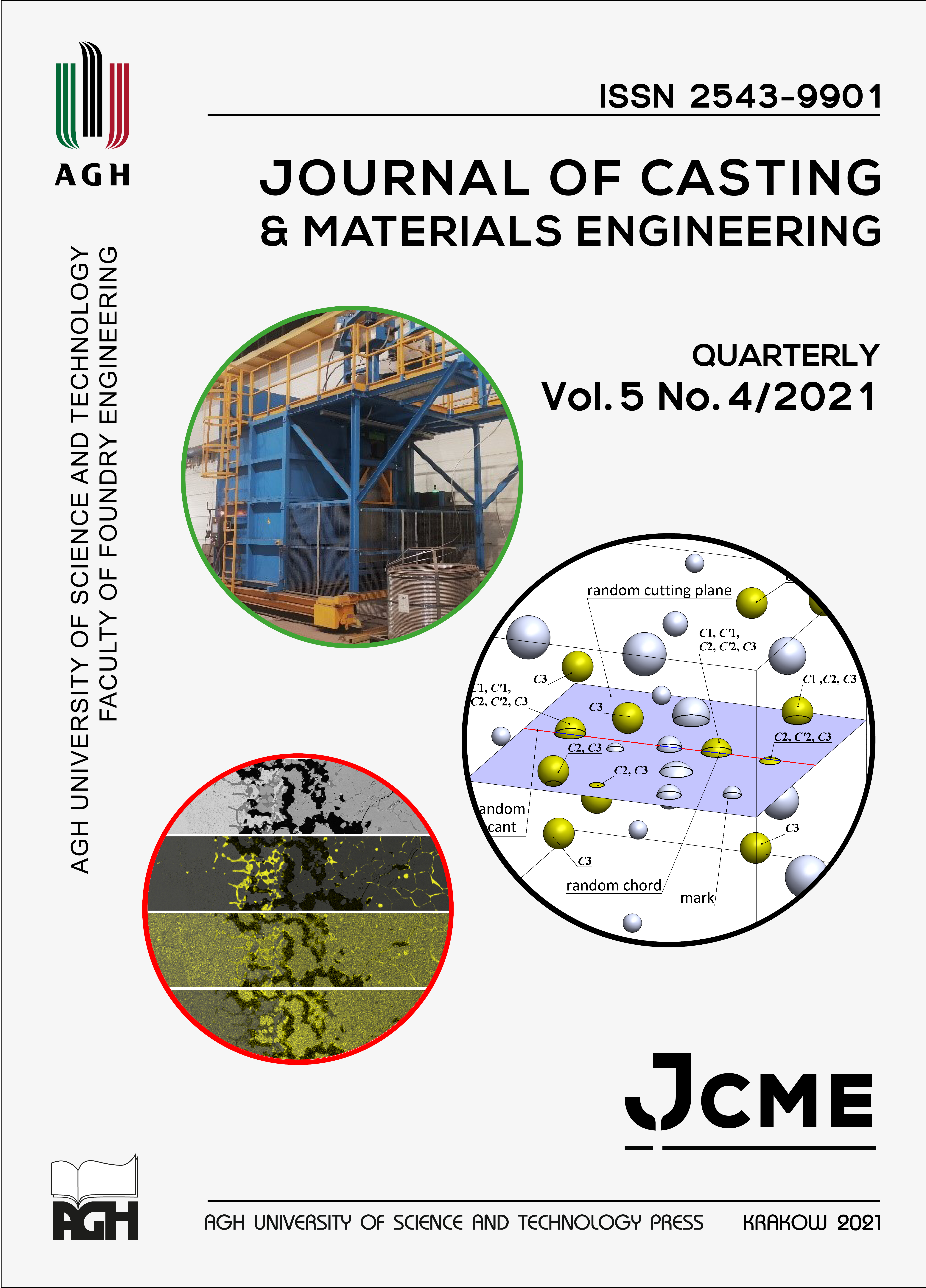Derivation of Equations for a Size Distribution of Spherical Particles in Non-Transparent Materials
DOI:
https://doi.org/10.7494/jcme.2021.5.4.53Abstract
This paper presents a new proposition on how to derive mathematical formulas that describe an unknown Probability Density Function (PDF3) of the spherical radii (r3) of particles randomly placed in non-transparent materials. We have presented two attempts here, both of which are based on data collected from a random planar cross-section passed through space containing three-dimensional nodules. The first attempt uses a Probability Density Function (PDF2) the form of which is experimentally obtained on the basis of a set containing two-dimensional radii (r2). These radii are produced by an intersection of the space by a random plane. In turn, the second solution also uses an experimentally obtained Probability Density Function (PDF1). But the form of PDF1 has been created on the basis of a set containing chord lengths collected from a cross-section.
The most important finding presented in this paper is the conclusion that if the PDF1 has proportional scopes, the PDF3 must have a constant value in these scopes. This fact allows stating that there are no nodules in the sample space that have particular radii belonging to the proportional ranges the PDF1.
Downloads
References
Wicksell S.D. (1925). The Corpuscle Problem: A Mathematical Study of a Biometric Problem. Biometric, 17(1–2), 84–89.
Sheil E. (1935). Statistische Gefügeuntersuchungen I. Zeitschrift für Metallkunde, 27(9), 199–208.
Schwartz H.A. (1934). The Metallographic Determination of the Size Distribution of Temper Carbon Nodules. Metals and Alloys, 5, 139–140.
Saltykov S.A. (1967). The Determination of the Size Distribution of Particles in an Opaque Material from the Measurement of the Size Distribution of their Section. In: The Second International Congress for Stereology, Chicago, 8–13 April 1967. Berlin – Heidelberg – New York, Springer Verlag.
Cahn J.W. & Fulmann R.L. (1956). On the Use of Lineal Analysis for Obtaining Particle Size Distributions in Opaque Samples. Transactions of the American Institute of Mining, Metallurgical and Petroleum Engineers, 206, 177–187.
Lord G.W. & Willis T.F. (1951). Calculation of Air Bubble Size Distribution from Results of a Rosiwal Traverse of Aerated Concrete. ASTM Bulletin, 177, 177–187.
Spektor A.G. (1950). Dispersionnyy analiz sfericheskikh chastits v neprozrachnykh strukturakh. Zavodskaya laboratoriya. Dia-gnostika, Materialov, 16(2), 173–177 [Спектор А.Г. (1950). Дисперсионный анализ сферических частиц в непрозрачных структурах. Заводская лаборатория. Диагностика материалов, 16(2), 173–177].
Hakahashi J. & Suito H. (2003). Evaluation of the Accuracy of the Three-Dimensional Size Distribution Estimated from the Schwartz–Saltykov Method. Metallurgical and Materials Transactions, 34A, 171–181.
Pedersen K.M. & Tiedje N.S. (2008). Graphite nodule count and size distribution in thin-walled ductile cast iron. Materials Characterization, 59, 1111–1121.
Mrzygłód B., Matusiewicz P., Tchórz A. & Olejarczyk-Wożeńska I. (2013). Quantitative Analysis of Ductile Iron Microstructure – A Comparison of Selected Methods for Assessment. Archives of Foundry Engineering, 13(3), 59–63.
Basak C.B. & Sengupta A.K. (2004). Development of a FDM based code to determine the 3-D size distribution of homogeneously dispersed spherical second phase from microstructure: A case study on nodular cast iron. Scripta Materialia, 51, 255–260.
Gurgul D., Burbelko A. & Wiktor T. (2018). Analysis of Spherical Particle Size Distribution – Theoretical Basis. Archives of Foundry Engineering, 18(1), 29–34.
Li T., Shimasaki S., Taniguchi S. & Narita S. (2016). Reliability of Inclusion Statistics in Steel Stereological Methods. ISIJ International, 56(9), 1625–1633.
Wiencek K., Skowronek T. & Khatemi B. (2005). Graphite Particle Size Distribution in Nodular Cast Iron. Metallurgy and Foundry Engineering, 31(2), 167–173.
Downloads
Published
Issue
Section
License
Copyright (c) 2021 Daniel Gurgul

This work is licensed under a Creative Commons Attribution 4.0 International License.
How to Cite
Accepted 2021-09-09
Published 2021-09-20


